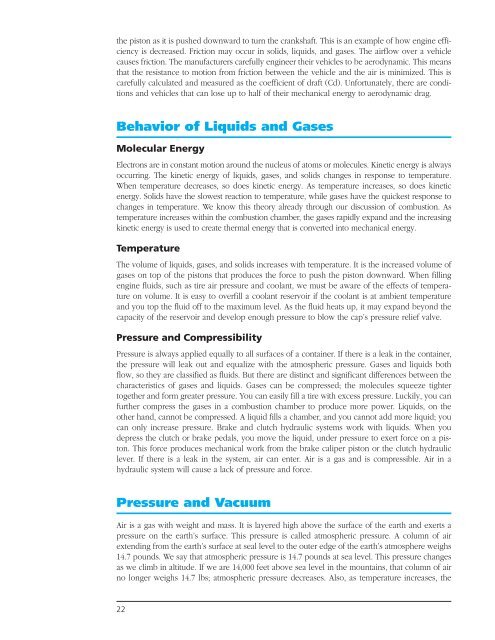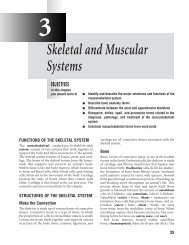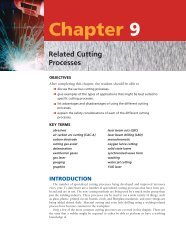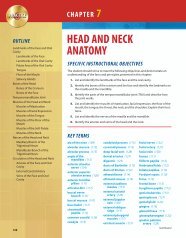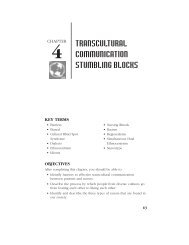Theory of Engine Operation - Delmar Learning
Theory of Engine Operation - Delmar Learning
Theory of Engine Operation - Delmar Learning
You also want an ePaper? Increase the reach of your titles
YUMPU automatically turns print PDFs into web optimized ePapers that Google loves.
the piston as it is pushed downward to turn the crankshaft. This is an example <strong>of</strong> how engine efficiency<br />
is decreased. Friction may occur in solids, liquids, and gases. The airflow over a vehicle<br />
causes friction. The manufacturers carefully engineer their vehicles to be aerodynamic. This means<br />
that the resistance to motion from friction between the vehicle and the air is minimized. This is<br />
carefully calculated and measured as the coefficient <strong>of</strong> draft (Cd). Unfortunately, there are conditions<br />
and vehicles that can lose up to half <strong>of</strong> their mechanical energy to aerodynamic drag.<br />
Behavior <strong>of</strong> Liquids and Gases<br />
Molecular Energy<br />
Electrons are in constant motion around the nucleus <strong>of</strong> atoms or molecules. Kinetic energy is always<br />
occurring. The kinetic energy <strong>of</strong> liquids, gases, and solids changes in response to temperature.<br />
When temperature decreases, so does kinetic energy. As temperature increases, so does kinetic<br />
energy. Solids have the slowest reaction to temperature, while gases have the quickest response to<br />
changes in temperature. We know this theory already through our discussion <strong>of</strong> combustion. As<br />
temperature increases within the combustion chamber, the gases rapidly expand and the increasing<br />
kinetic energy is used to create thermal energy that is converted into mechanical energy.<br />
Temperature<br />
The volume <strong>of</strong> liquids, gases, and solids increases with temperature. It is the increased volume <strong>of</strong><br />
gases on top <strong>of</strong> the pistons that produces the force to push the piston downward. When filling<br />
engine fluids, such as tire air pressure and coolant, we must be aware <strong>of</strong> the effects <strong>of</strong> temperature<br />
on volume. It is easy to overfill a coolant reservoir if the coolant is at ambient temperature<br />
and you top the fluid <strong>of</strong>f to the maximum level. As the fluid heats up, it may expand beyond the<br />
capacity <strong>of</strong> the reservoir and develop enough pressure to blow the cap’s pressure relief valve.<br />
Pressure and Compressibility<br />
Pressure is always applied equally to all surfaces <strong>of</strong> a container. If there is a leak in the container,<br />
the pressure will leak out and equalize with the atmospheric pressure. Gases and liquids both<br />
flow, so they are classified as fluids. But there are distinct and significant differences between the<br />
characteristics <strong>of</strong> gases and liquids. Gases can be compressed; the molecules squeeze tighter<br />
together and form greater pressure. You can easily fill a tire with excess pressure. Luckily, you can<br />
further compress the gases in a combustion chamber to produce more power. Liquids, on the<br />
other hand, cannot be compressed. A liquid fills a chamber, and you cannot add more liquid; you<br />
can only increase pressure. Brake and clutch hydraulic systems work with liquids. When you<br />
depress the clutch or brake pedals, you move the liquid, under pressure to exert force on a piston.<br />
This force produces mechanical work from the brake caliper piston or the clutch hydraulic<br />
lever. If there is a leak in the system, air can enter. Air is a gas and is compressible. Air in a<br />
hydraulic system will cause a lack <strong>of</strong> pressure and force.<br />
Pressure and Vacuum<br />
Air is a gas with weight and mass. It is layered high above the surface <strong>of</strong> the earth and exerts a<br />
pressure on the earth’s surface. This pressure is called atmospheric pressure. A column <strong>of</strong> air<br />
extending from the earth’s surface at seal level to the outer edge <strong>of</strong> the earth’s atmosphere weighs<br />
14.7 pounds. We say that atmospheric pressure is 14.7 pounds at sea level. This pressure changes<br />
as we climb in altitude. If we are 14,000 feet above sea level in the mountains, that column <strong>of</strong> air<br />
no longer weighs 14.7 lbs; atmospheric pressure decreases. Also, as temperature increases, the<br />
22


